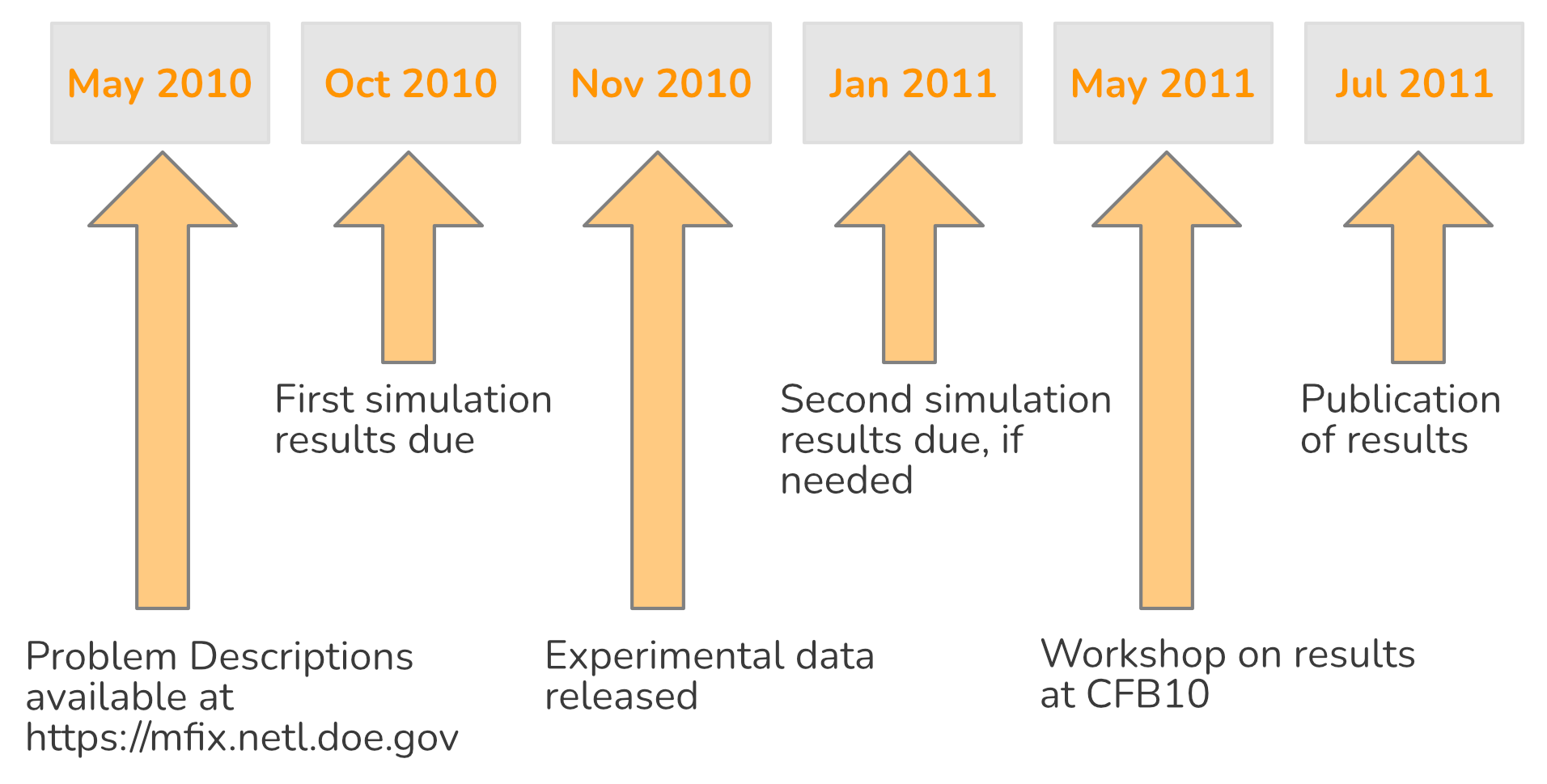Challenge Problems
NETL Challenge Problem III (2010): NETL’s Circulating Fluidized Bed (CFB) and PSRI’s Bubbling Fluid Bed (BFB)

Experimental Data | |||
|---|---|---|---|
| File | Size | Year | |
| CFB Experimental Data (XLS) | 2.7 MB | 2011 | |
| CFB case 3 Videos (ZIP) | 58.7 MB | 2011 | |
| CFB case 4 Videos (ZIP) | 46.8 MB | 2011 | |
| CFB case 5 Videos (ZIP) | 67.3 MB | 2011 | |
| CFB facility pictures (ZIP) | 4.2 MB | 2011 | |
| BFB Experimental Data (XLS) | 403 KB | 2011 | |
| BFB facility pictures (ZIP) | 13.7 MB | 2011 | |
To: All Gas-Solids Fluid Bed Computational modelers
From: L. Shadle, C. Guenther, R. Cocco, and R. Panday
Date: May 9, 2010
Subject: Challenge Problem 3
At Fluidization VII, Prof. John Chen proposed a scenario whereby hydrodynamic data would be taken on circulating fluidized-bed test units to be used as a basis for validation of mathematical models of risers in the test units. A description of the unit(s), the test conditions, and a description of the materials used would be made available to the research community at large and they would be challenged to predict the data that were produced. The purpose of this type of benchmark experiment/challenge problem was to determine the state-of-art of hydrodynamic models. The first benchmark experiment was conducted via the first PSRI Challenge Problem. The agreement between the predictions of the various models and the data were presented at Fluidization VIII, in Tours, France in 1995. PSRI conducted a second Challenge Problem that was presented at Fluidization X in Xian, China, in 2001.
NETL, in collaboration with PSRI, generated a third Challenge Problem from data generated in NETL’s Circulating Fluidized Bed and PSRI’s bubbling fluid bed. Modelers from industries, universities and research organizations participated to predict the data with their hydrodynamic model. A description of the experimental unit used to obtain the hydrodynamic data, material parameters for Geldart Group A and B test materials, and test conditions/parameters were enclosed. In addition, gas and particle properties were provided including the entire particle size distribution. Minimum fluidization and bubbling curves with bed density profiles were available including a CAD of the unit in which these measurements were collected. Modelers could validate against the known design and operating conditions with the results from this simple system before modeling the challenge problems.
After submission of the first modeling results for the challenge problems, modelers could refine their model against the data available.
Several modelers submitted their refined model results. All input model results were handled confidentially. Model input results were assigned a random model number so that contributors could track the performance of their results anonymously. Validation results were presented at the CFB X conference held in Sun River Valley, Oregon, USA in May 2011.
Challenge Problem 3 Files | |||
|---|---|---|---|
| File | Size | Year | |
| CFB Challenge Problem (XLS) | 1.8 MB | 2010 | |
| BFB Challenge Problem (XLS) | 356 K | 2010 | |
| Fluidization Modeling Challenge Brochure (PDF) | 500 K | 2010 | |
| Poster at 2010 Multiphase Workshop (PDF) | 521 K | 2010 | |
| Powder Tech Note (PDF) | 25 K | 2010 | |
CFB CAD Files | |||
|---|---|---|---|
| File | Size | Year | |
| STL format (ASCII) | 745 K | 2010 | |
| STEP format (ASCII) | 126 K | 2010 | |
| STEP format, cleaned-up by Gambit (ASCII) | 233 K | 2010 | |
| PARASOLID format (ASCII) | 132 K | 2010 | |
| PARASOLID format (BINARY) | 78 K | 2010 | |
| View #1 of CFB (PDF) | 17 K | 2010 | |
| View #2 of CFB (PDF) | 25 K | 2010 | |
BFB CAD Files | |||
|---|---|---|---|
| File | Size | Year | |
| STL format (ASCII) | 977 K | 2010 | |
If you have any comments, questions or suggestions on Challenge Problem III, please send them to
Rupen Panday
Challenge Problem III Principal Investigator
National Energy Technology Laboratory
3610 Collins Ferry Rd.
Morgantown, WV 26507-0880 ,USA
Phone: 304-285-4286
E-mail: pa*****@******oe.gov

